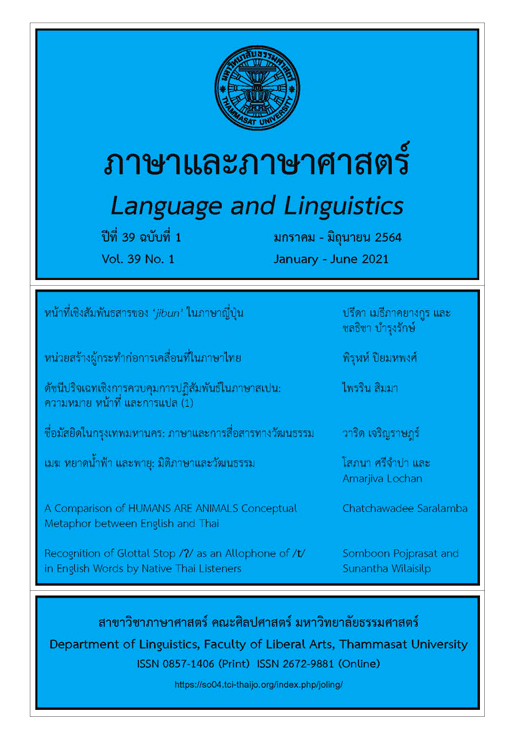The Names of Mosques in Bangkok: Language and Interpretation of Cultures
Main Article Content
Abstract
The aims of this research are to analyze language usage in naming mosques in Bangkok, including language origin and meaning; and also to study reflections from the interpretation of cultures in those mosque names. The research data involved 183 mosque names in Bangkok, compiled from both registered and unregistered mosques. Qualitative research methods were employed in this research and; the data were analyzed according to the research objectives. The results show that language usage to name mosques in Bangkok can be divided into four types, including 166 Arabic names (90.71%); 11 Thai names (6.01%); 3 Thai mixed with Arabic names (1.64%); 2 Malay-Java names (1.09%); and 1 Thai mixed with Urdu name (0.55%) respectively. In terms of the meanings of mosque names, there are 11 categories including 38 names on meaning characteristics from the religion of Islam (20.76%); 23 names on the meaning of love, harmony and unity within Islam (12.11%); 21 names on the meaning of places and buildings (11.46%); 21 names on the meaning of morality and goodness (11.46%); 21 names on the meaning of guidance (also called “Hidayah”) (11.46%); 18 names on the meaning of faith, piety and fear of Allah (also known as “Taqwa”) (6.00%); 11 names on the meaning of heaven (6.00%); 9 names on meaning of loyalty to Allah (4.92%); 7 names on the meaning of appellation and characteristics of Allah (3.82%); and 4 famous people names (2.18%), respectively. There are 6 groups of the reflections about interpretation of cultures from mosques’ names in Bangkok, including building faith in the unity of Allah (also known as “Tawhid”); persisting in Islamic society; conducting insurance (also known as “Takaful”) and reciprocity in heaven; defining Islamic identity; cultivating Islamic morality; and recording community history. The results also indicate that, according to the Royal Policy for Education of His Majesty King Maha Vajiralongkorn Bodindradebayavarangkun (King Rama X), the identity and thinking system of Thai-Muslim people are most important to strengthen peace in this multicultural society.
Article Details
บทความทุกบทความเป็นลิขสิทธิ์ของภาษาและภาษาศาสตร์
References
กระทรวงศึกษาธิการ. (2559). หลักสูตรอิสลามศึกษาฟัรฏูอีนประจำมัสยิด ระดับอิสลามศึกษาตอนต้น (อิบติดาอิยะฮ์) พ.ศ. 2559. กระทรวงศึกษาธิการ.
ชัชวดี ศรลัมพ์. (2549). อุปลักษณ์เชิงมโนทัศน์ในนาฏยภาษา. มหาวิทยาลัยธรรมศาสตร์.
ต่วน สุวรรณศาสน์. (2519). ศาสนาอิสลาม ฉบับของสำนักจุฬาราชมนตรี. กรมศาสนา.
บรรจง บินกาซัน. (2547). สารานุกรมอิสลาม (พิมพ์ครั้งที่ 2). อัลอะมีน.
ปฐม หงษ์สุวรรณ. (2550). บทบาทของ “หมา” ในตำนานและพิธีกรรมของชาติพันธุ์ต่าง ๆ ในอุษาคเนย์. ใน กาลครั้งหนึ่ง: ว่าด้วยตำนานกับวัฒนธรรม (น. 213-231). จุฬาลงกรณ์มหาวิทยาลัย.
ประชุมพงศาวดาร เล่มที่ 11. (2507). องค์การค้าของคุรุสภา.
พิเชฐ แสงทอง. (2539). นาคใน “นาคาคติ” อีสานลุ่มน้ำโขง: ชีวิตทางวัฒนธรรมจากพิธีกรรมร่วมสมัย [วิทยานิพนธ์ปริญญามหาบัณฑิต]. จุฬาลงกรณ์มหาวิทยาลัย.
วีรศักดิ์ จารุโณปถัมภ์. (2544). สัญลักษณ์พระสยามเทวาธิราช: การวิเคราะห์และตีความหมายเชิงมานุษยวิทยา. จุฬาลงกรณ์มหาวิทยาลัย.
ศูนย์กลางอิสลามแห่งประเทศไทย. (2530). ประเทศไทยกับโลกมุสลิม. โรงพิมพ์องค์การสงเคราะห์ทหารผ่านศึก.
สมาคมนักเรียนเก่าอาหรับ. (1919). พระมหาคัมภีร์อัล-กุรอาน พร้อมคำแปลเป็นภาษาไทย. ศูนย์กษัตริย์ฟาฮัด เพื่อการพิมพ์อัลกุรอาน.
สำนักงานสถิติแห่งชาติ. (2562). รายงานผลสำมะโน/ สำรวจ. http://www.nso.go.th/sites/2014/Pages/เอกสารเผยแพร่/เอกสารเผยแพร่1130-3494.aspx
อาดิศร์ อิดรีส รักษมณี. (2558). มัสยิดในกรุงเทพมหานคร. มติชน.
อานันท์ กาญจนพันธุ์. (2534). ความเป็นชาติพันธุ์. ใน อานันท์ กาญจนพันธุ์(บรรณาธิการ), แนวความคิดพื้นฐานทางสังคมและวัฒนธรรม (น. 187-195). โรงพิมพ์มหาวิทยาลัยธรรมศาสตร์.
อาลี เสือสมิง. (2556). อารยธรรมอิสลาม Islamic Civilization. นัทชาพริ้นติ้ง.
Geertz, C. (1973). The Integrative revolution: Primordial sentimes and civil politics in the new states. In C. Greertz (Ed), Old societies and NS states: The quest for modernity in Asia and Africa (pp. 105-157). The Free Press of Glencoe.
Hall, S. (2003). Representation: Cultural representations and signifying practices. SAGE Publications.
Lakoff, G., & Johnson, M. (1980). Metaphors we live by. The University of Chicago Press.
Taunen, D. (2006). Language and culture. In R. Fasold & J. Connor – Linton (Eds.), An introduction to language and linguistic. Cambridge University Press.


